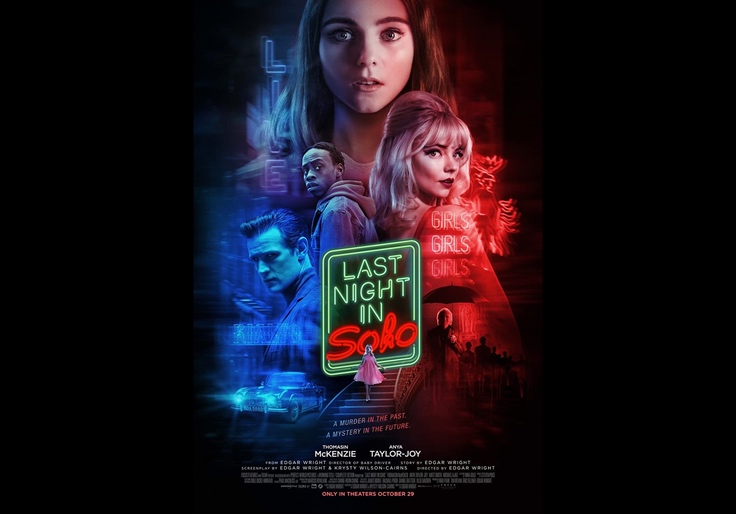The dazzling new movie Last Night in Soho is a bizarro-world version of Once Upon a Time… in Hollywood. Both movies are about the power of nostalgia. Tarantino's wonderful picture took one of modern history's most disturbing real-life horror stories—the Manson family murders—and transmuted it into crazy comedy. It was a deliberate sanitization of the truth about 1960s Los Angeles, a conscious study of the power movies have when it comes to romanticizing the past.
Last Night in Soho, from the singularly gifted writer-director Edgar Wright, does exactly the opposite. It's the story of Ellie, a young British would-be fashion designer, who hungers so deeply for the culture and glamour of 1960s London that she begins to time-travel there in her dreams—and then must suffer as those exciting and beautiful dreams slowly turn into terrifying nightmares.
Ellie, who has inherited either her late mother's schizophrenia or her supernatural sensitivity, watches (and partially inhabits the body of) Sandie—herself a young would-be chanteuse who lived in the same flat Ellie now inhabits, but six decades earlier.
During the day, in contemporary London, Ellie walks the same streets in Soho she sees Sandie dancing through at night. Theater marquees selling Sean Connery in Thunderball lead to the entrances to glamorous smoke-filled supper clubs where Sandie hopes to work as a singer and dancer. Wright follows Tarantino's lead in pulling off an utterly miraculous re-creation of the swinging '60s, so much so that you can understand entirely why Ellie can't wait to go home and go to sleep at 8 p.m. so she can return there.
Ellie also begins to model herself on Sandie, buying a vintage 1960s coat she has seen Sandie wearing in her visions and dyeing her brown hair a Sandie shade of blonde. Soon, though, Ellie discovers that the world Sandie inhabits is full of men who don't want Sandie for her gifts or her charms but for different, darker entertainment. And Ellie finds that she can't escape the visions and must watch and, in part, participate in Sandie's descent into a personal hell.
Though his most famous picture is his 2017 hit Baby Driver, Edgar Wright is best known for multilayered comedies that observe classic genre conventions (the zombie picture Shaun of the Dead, the buddy-cop movie Hot Fuzz) but twist them around in new and interesting ways. But there's nothing really comic about Last Night in Soho. Working from an original script coauthored by Kristy Wilson-Cairns, a prodigious young talent who also helped write 1917, Wright has made his best movie so far—a movie that's a far more effective and far more complicated portrait of the horrors of the "male gaze" than the wildly overpraised Promising Young Woman.
In part that's because of the utterly astonishing Thomasin McKenzie, whose work as Ellie is comparable in force and originality to Mia Farrow's indelible turn in 1968's Rosemary's Baby (then and now the greatest female performance in any horror movie and the model for almost everyone that followed her). McKenzie, who hails from New Zealand and is only known to me from her supporting role as the hidden Jewish girl in Jojo Rabbit, is heartbreakingly lovable and more than a little odd—and, like Farrow, leaves us very much unsure whether she is experiencing something occult or is instead having a breakdown.
Anya Taylor-Joy, so memorable as the tormented chess genius in the great Netflix series The Queen's Gambit, does a stellar turn here as the victimized and yet not-so-victimized Sandie. And the 83-year-old Terence Stamp, an important social and cultural figure during the heyday of Swinging London, is both menacing and touching as a glamour boy gone to seed.
"Did someone die in this room?" Ellie asks her landlady (the late Diana Rigg, in her last role). "Oh, dear, someone has died in every room in London," the landlady responds. Last Night in Soho offers us a glorious view of the glittering days of the past only to remind us that nostalgia is a smokescreen that disguises and prettifies the ugliness of human nature, which was, of course, as much a feature of life then as it is now.
